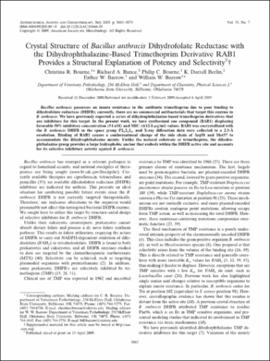| dc.contributor.author | Bourne, Christina R. | |
| dc.contributor.author | Bunce, Richard A. | |
| dc.contributor.author | Bourne, Philip C. | |
| dc.contributor.author | Berlin, K. Darrell | |
| dc.contributor.author | Barrow, Esther W. | |
| dc.contributor.author | Barrow, William W. | |
| dc.date.accessioned | 2018-08-17T16:24:53Z | |
| dc.date.available | 2018-08-17T16:24:53Z | |
| dc.date.issued | 2009-07 | |
| dc.identifier | oksd_bourne_crystalstructur_2009 | |
| dc.identifier.citation | Bourne, C. R., Bunce, R. A., Bourne, P. C., Berlin, K. D., Barrow, E. W., & Barrow, W. W. (2009). Crystal structure of Bacillus anthracis dihydrofolate reductase with the dihydrophthalazine-based trimethoprim derivative RAB1 provides a structural explanation of potency and selectivity. Antimicrobial Agents and Chemotherapy, 53(7), 3065-3073. https://doi.org/10.1128/AAC.01666-08 | |
| dc.identifier.uri | https://hdl.handle.net/11244/301442 | |
| dc.description.abstract | Bacillus anthracis possesses an innate resistance to the antibiotic trimethoprim due to poor binding to dihydrofolate reductase (DHFR); currently, there are no commercial antibacterials that target this enzyme in B. anthracis. We have previously reported a series of dihydrophthalazine-based trimethoprim derivatives that are inhibitors for this target. In the present work, we have synthesized one compound (RAB1) displaying favorable 50% inhibitory concentration (54 nM) and MIC (</=12.8 ug/ml) values. RAB1 was cocrystallized with the B. anthracis DHFR in the space group P212121, and X-ray diffraction data were collected to a 2.3-A resolution. Binding of RAB1 causes a conformational change of the side chain of Arg58 and Met37 to accommodate the dihydrophthalazine moiety. Unlike the natural substrate or trimethoprim, the dihydrophthalazine group provides a large hydrophobic anchor that embeds within the DHFR active site and accounts for its selective inhibitory activity against B. anthracis. | |
| dc.format | application/pdf | |
| dc.language | en_US | |
| dc.publisher | American Society for Microbiology | |
| dc.rights | This material has been previously published. In the Oklahoma State University Library's institutional repository this version is made available through the open access principles and the terms of agreement/consent between the author(s) and the publisher. The permission policy on the use, reproduction or distribution of the material falls under fair use for educational, scholarship, and research purposes. Contact Digital Resources and Discovery Services at lib-dls@okstate.edu or 405-744-9161 for further information. | |
| dc.title | Crystal structure of Bacillus anthracis dihydrofolate reductase with the dihydrophthalazine-based trimethoprim derivative RAB1 provides a structural explanation of potency and selectivity | |
| osu.filename | oksd_bourne_crystalstructur_2009.pdf | |
| dc.description.peerreview | Peer reviewed | |
| dc.identifier.doi | 10.1128/AAC.01666-08 | |
| dc.description.department | Veterinary Pathobiology | |
| dc.description.department | Chemistry | |
| dc.type.genre | Article | |
| dc.type.material | Text | |
| dc.subject.keywords | antiinfectious | |
| dc.subject.keywords | antibacterial agent | |
| dc.subject.keywords | selectivity | |
| dc.subject.keywords | trimethoprim | |
| dc.subject.keywords | dihydrofolate reductase | |
| dc.subject.keywords | bacillus anthracis | |
| dc.subject.keywords | crystalline structure | |
| dc.subject.keywords | pyrimidine derivatives | |
| dc.subject.keywords | antifolate | |
| dc.subject.keywords | enzyme | |
| dc.subject.keywords | oxidoreductases | |
| dc.subject.keywords | bacteria | |
| dc.subject.keywords | bacillales | |
| dc.subject.keywords | bacillaceae | |
